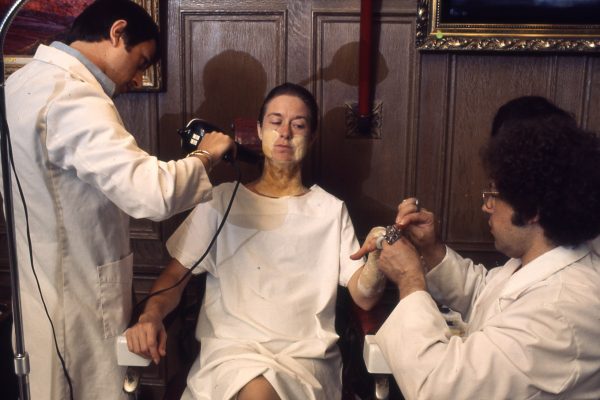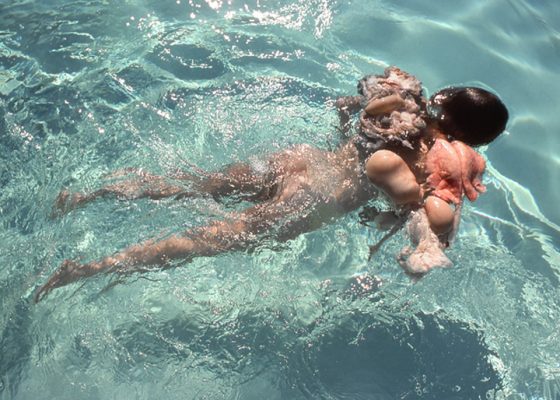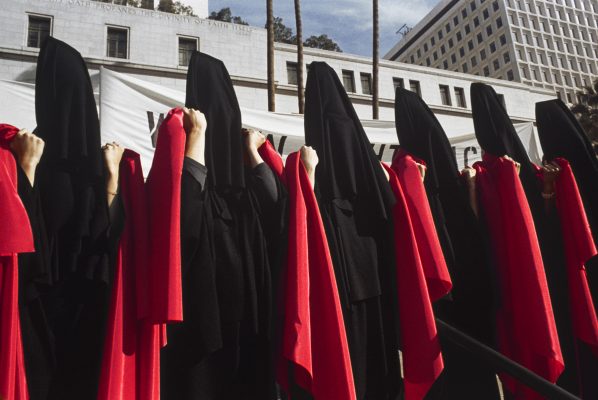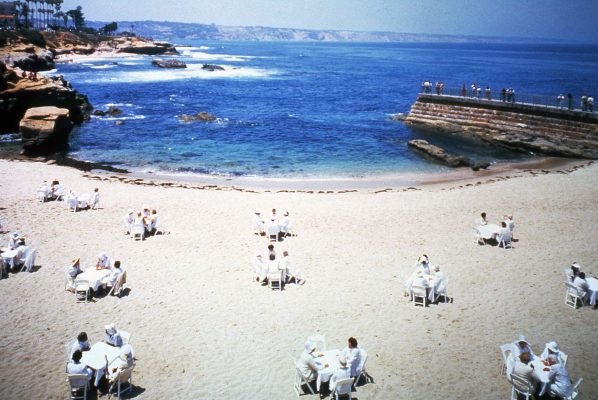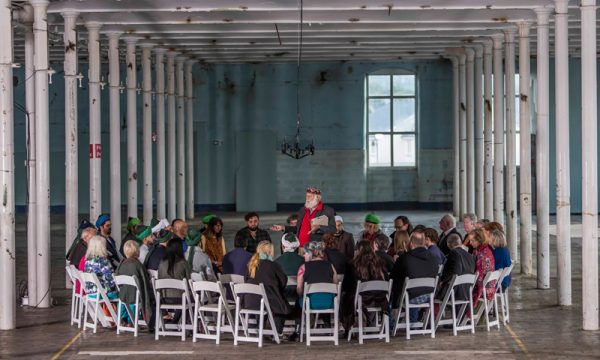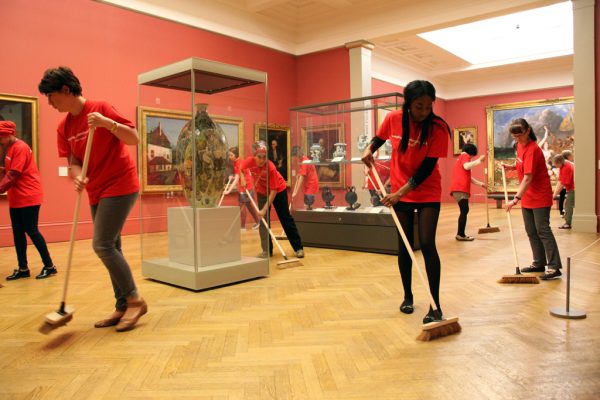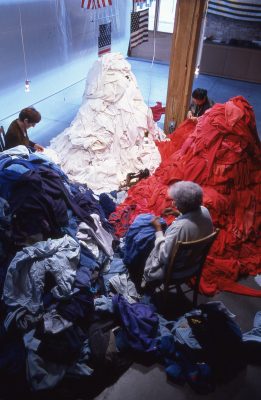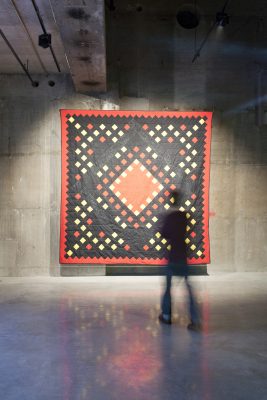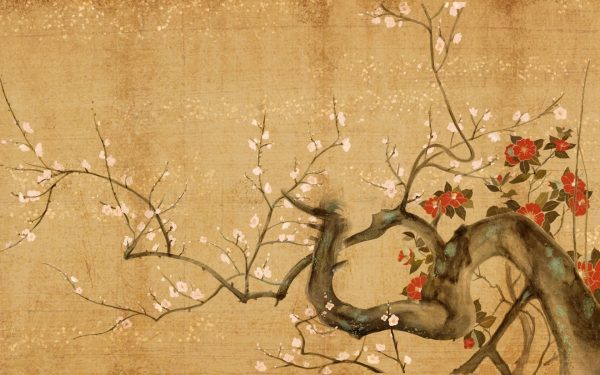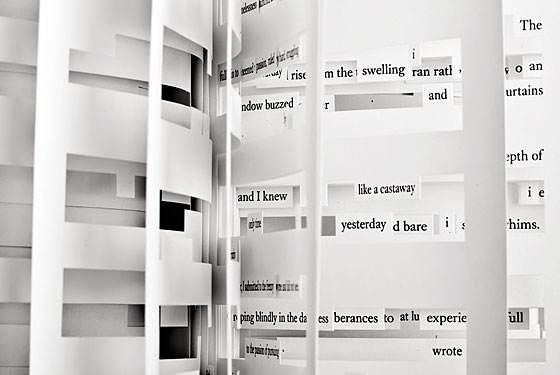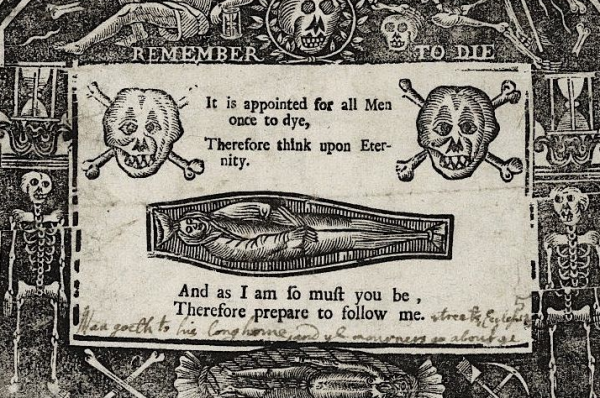Friendship often requires the careful dance of shared time and being attentive to one another’s needs. Recently when I visited San Francisco with my two closest friends, we spent a lot of time seeking cheap dinners at different times of day, according to the various cycles of our appetites—deli sandwiches, burritos, greasy slices of pizza, hot dogs slathered with sweet onions and mustard. It became essential to learn the rhythms of each other’s bodies, aches and pains. Then there is the matter of overcoming the small irritations, the disputes over rules for card games, or who owes money for last night’s round of drinks.
On day one of our trip we visited We Are Here at San Francisco Museum of Modern Art (SFMOMA), the first retrospective dedicated to artist and activist Suzanne Lacy’s over-forty-year career. Lacy is interested in hunger and waiting, sharing food, and the anticipation and patience that attends communality. As the exhibition shows, her formal and thematic concerns have remained pretty much consistent: food, dinner parties, tables, maps, quilting. Among her best-known works is The Crystal Quilt (1985-7), for which she brought together more than 400 women over the age of 60 to discuss their views on growing older while collectively producing a quilt. She has since staged various versions of this social action, including ‘Silver Action’ at Tate Modern in 2013. It’s because of works like this that I think of her career as productively ghostly and incomplete. Lacy is committed to waiting things out, to seeing things through over and again — whether pleasurable, uncomfortable or violent.
On display in the middle of the exhibition is a set of photographs depicting one of Lacy’s first collaborative performance works, Ablutions (1972). The images show three bathtubs in the middle of a gallery filled with blood and clay. Broken eggshells and animal kidneys are scattered across the space. In the early seventies, when sexual violence against a spouse was still legal in California, Lacy, Judy Chicago, Sandra Orgel and Aviva Rahmani’s Ablutions (1972) placed women in the gallery. During the original performance disembodiedvoices, disseminated through speakers around the gallery space, related the explicit details of their rapes. Meanwhile the artists bathed in the tubs, lathering themselves in egg, blood and clay. An unnamed nude woman was bound with gauze bandages; Lacy nailed fifty beef kidneys to the wall. Lacy’s works often speak of sexual and gendered violence, but also how we seek out thepossibility of intimacy in sharing these stories, and how we might partake in trauma with others through the therapeutic act of re-living and re-telling. At We Are Here, the audience can stand in a darkened booth and listen to these recordings. They are matter-of-fact, explicit — we are asked to give our time, to wait with them again.
Curator of We Are Here, Rudolf Freiling, comments that Lacy’s ‘projects are not over – the artist rewrites the script and the framing of these works from the perspective of our time.’ This reiterative methodology is important for understanding trauma itself. Lacy rewrites works about sexual and gendered violence over the course of her career. We might think of Three Weeks in May (1977), a work for which she spent three weeks stamping the word ‘RAPE’ on a large map of Los Angeles, where she collected daily police reports that recorded rapes taking place, which she reprised in 2012 for a performance entitled Three Weeks in January. If, as scholar Cathy Caruth famously argues, trauma is the literal return of an event against one’s will, Lacy’s reiterations question whether healing from trauma is ever totally possible, or if it simply bleeds into, and becomes a part of, ordinary life: a type of labour to be repeated rather than finished.
Before Lacy became an artist, she undertook a zoology degree. We see her interest in anatomy in Ablutions: women become meat in the assemblages of bodies, biological messand animal carcasses that fill the stage. In a series of photographs entitled Chickens Coming Home to Roost (1975-76), Lacy sits at a table naked; in front of her is a tub of chicken. In writing superimposed on the photographs, the word ‘arm’ is printed next to her arm; ‘wing’ next to a chicken wing. Through this associative placement, Lacy compares her own anatomy with that of the animal, her body to meat. In one image she gnaws at the flesh, holding it between her teeth, her eyes closed in a combination of pleasure and apprehension as it touches her lips.
The use of food in Chickens Coming Home to Roost is visceral, messy and carnal. In this respect it differs from much of Lacy’s practice, where it was typically used — as was often the case in feminist performance art in the 1970s, according to critic Lucy Lippard — to speak of domesticity, repair, community and healing. These more familiar themes are visible in a collection of letters on display in a vitrine. ‘Dear Suzanne, I will be giving a dinner party for my Very Best Friends’, reads one, addressed to Lacy from Rachel Rosenthal, who also explains that they will be ‘honoring our mothers’ by making a video work. This party was an extension of Lacy’s International Dinner Party series (1979), which she organised in collaboration with women across the globe. Rosenthal informs Lacy that she plans on serving ‘Chicken Bouillon, Soup with Cabbage Piroshki. Also salad, Fromage, and a Lemon Pound Cake.’ She ends the letter, ‘Hurrah for Women’.
In another document, we learn that Ana Mendieta and Mary Beth Edelstein hosted their own party as part of International Dinner Party to ‘Honor Louise Bourgeois’, with guests including Hannah Wilkie, Judith Bernstein and Barbara Zucker present. With both an enviable guest list and menu—champagne supplied by Bourgeois herself, red caviar and sour cream on crackers, turkey, acorn squash and homemade flan—the dinner provided a space to come together, to discuss and critique, to share in the remedial nature of food.
Lacy would continue to keep the table in place and disappear the food upon it. During the late seventies, her interest in community turned to large scale, durational works. In Whisper, the Waves, the Winds (1983-4), she worked with a group of women, aged 65 and above, to produce a performance that took place next to the ocean in La Jolla, California. Continuing the theme of The Crystal Quilt, the women came together to discuss the vicissitudes of ageing. In a series of photographs of the event, the blue of the sea contrasts with the white tablecloths and outfits that the participants are wearing. An audience watch from the cliffs, and seagulls dip in and out of the tooth-spit waves.
Lacy continues to make work that unspools generously into the social, in which attention to detail and a sense of controlled authorship combine with collaboration and community. She has taught me the sometimes painful but potentially restorative process of remaining with difficulty and discomfort, and that sometimes feelings will settle into the grit your bones, because they don’t always wash away quickly.
share
ABOUT THE CONTRIBUTOR
Bryony White
is currently finishing her PhD at King’s College London where she is writing on the legal regulation of queer, racialized and non-normative bodies in performance. She has written for frieze, Artmonthly, LA Review of Books and Hazlitt. In 2019, she was shortlisted for the Fitzcarraldo Editions Essay Prize and is currently working on her first non-fiction book, Common Periwinkle.
